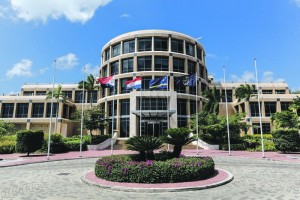Central Bank: “Economic Growth In Curaçao Remained Flat In 2016”
Central Bank: “Economic Growth In Curaçao Remained Flat In 2016”
 WILLEMSTAD - Preliminary data suggest that economic growth in Curaçao remained flat in 2016 (0.0%), following an increase of 0.3% in 2015. Meanwhile, real GDP expanded by a mere 0.1% in Sint Maarten, a slowdown compared to the 0.4% growth registered in 2015. Both countries recorded a deflation –a decline in the average prices- on the account of a fall in international oil prices.
WILLEMSTAD - Preliminary data suggest that economic growth in Curaçao remained flat in 2016 (0.0%), following an increase of 0.3% in 2015. Meanwhile, real GDP expanded by a mere 0.1% in Sint Maarten, a slowdown compared to the 0.4% growth registered in 2015. Both countries recorded a deflation –a decline in the average prices- on the account of a fall in international oil prices.
The economic stagnation in Curaçao was caused by a growth in domestic demand offset by a drop in net foreign demand. Domestic demand grew because of higher private and public spending. Both consumption and investment contributed to the rise in private spending. Meanwhile, public demand was up as a result of an increase investments, including the construction of the new hospital and the upgrading of the road infrastructure. Also, public consumption increased because of more disbursements on goods & services. The negative contribution of net foreign demand was caused by a decline in exports that surpassed the lower imports. A sectoral analysis shows that real value added increased in the construction, financial intermediation and utilities sectors, while the restaurants & hotels, manufacturing, wholesale & retail trade, and transport, storage and communication sectors recorded a contraction.
In Sint Maarten, real GDP expansion in 2016 was driven by private demand only. The increase in private demand was the result of more investments mitigated by a decline in consumption. By contrast, public demand dropped as both consumption and investment spending by the government contracted. Furthermore, net foreign demand contributed negatively to growth because of a decline in exports moderated by lower imports. The decline in exports was caused primarily by a sharp drop in foreign exchange earnings from cruise tourism. On the production side, growth was sustained by the construction, manufacturing and utilities sectors, dampened by a contraction in the wholesale & retail trade, restaurants & hotels, transport, storage & communication, and real estate, renting and business activities sectors.
On the fiscal front, both Curaçao and Sint Maarten expect a surplus on their current budget in 2016. Nevertheless, issues that might pose a risk to the sustainability of the public finances in the medium term remain and, hence, need to be addressed. In the case of Curaçao, the deficit of the old-age pension fund (AOV), that is being financed through budgetary transfers, requires the necessary policy actions by the government. In addition, Curaçao’s debt-to-GDP ratio is currently above the benchmark of 40% that is considered prudent for a small open economy, while economic growth has remained lackluster. Consequently, the government will have to take measures that stimulate a higher growth path to ensure debt sustainability in the medium term. In Sint Maarten, the government still needs to implement measures to increase its revenues in a more sustainable manner, including the strengthening of the tax department. Moreover, measures to comply with the September 2015 instruction of the Kingdom Council of Ministers still need to be implemented, including reform of the pension and social security systems and improving financial management.
In 2017, both countries will benefit, albeit modestly, from the projected higher global economic growth. The economy of Curaçao will expand by a projected 0.4% in 2017 driven by increases in private and public spending. By contrast, a decline in net foreign demand will dampen the economic expansion. Sint Maarten’s economy is projected to grow by 0.5%, ascribable to higher private spending, dampened by decreases in public spending and net foreign demand.



Comments
Post a Comment